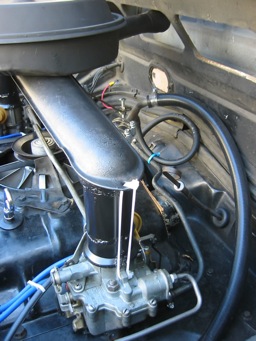
Your engine needs three basic things to run - fuel, air, and spark - to run. But unfiltered air will wear things out fast, so let's look at how to get a clean supply of air to the engine.
The stock air filter system was designed to not only clean the air going into the engine, but also cut down on noise from the intake tract. Since the dyno runs were usually done without an air filter, there wasn't a lot of thought put into the restrictions. It turns out that the actual filter area and housing is pretty good, but there are a couple of restrictions that you can fix.
Fortunately the fix is quite simple for Corvairs with the large central air filter assemply, just add a spacer tube to raise the air filter. Most lates and '64 earlies use this housing, so this will work on most Corvairs. See the photos below, or go to Matt Nall's High Rise page for more details. BTW, Matt reported the highway fuel mileage on a stock 47 k mile 69 110 hp with 3.27s went from 24 to 27 with this mod alone.
| Click on an image to see the full size version. | |
|---|---|
 |
 |

If you decide to get rid of the stock setup entirely, you can replace it either with the cool Otto Parts filters if you have a 140, or with generic K&N or other filters designed to fit over a single throat carb. Bear in mind that hooking up the PCV system is a good idea as it will promote better ring sealing. The carb throat diameter is 2 1/4", here's a setup with parts from the local home supply plumbing section. Get some "no hub couplers" and PVC connectors to adapt K&N air filters, with a 3/8" brass nipple into one of the connectors for the PCV line. One other advantage to individual filters is that access to the engine for tuning is much better.
It's also be possible to set up ducting from the air plenum at the front of the engine compartment, thus avoiding recirculating any hot air from the bottom of the engine. Wade Lanning did this on an air conditioned late model:
It did require cutting a hole into the plenum where the voltage regulator used to reside before converting the alternator to internal regualtor. The intake snout is from a Pontiac "Tech IV" 4-cylinder air cleaner (look for eBay description "1984-1988 Pontiac Fiero Air Cleaner Assembly W/Fresh Air Hose And Lid" - Wade is using the snorkel upside dawn). I didn't use the entire Pontiac air cleaner, just the snout. The air cleaner housing was the same diameter as the Corvair, so I was able to cut the snout off the Pontiac air cleaner and tack weld it on the Corvair air cleaner after removing its snout. If I recall, in order for the PCV tube to still hook into the bottom of the air cleaner I had to fill in the hole left by the snout removal and cut a new hole for the Pontiac snout to aim it in the correct direction while still hooking into the PCV tube. However there was the recent Communique tech tip by Mark Corbin about hooking the pcv tube into the crossover between the air cleaner and the carbs that eliminated the PCV tube in the bottom of the air cleaner. This might be a better approach.
Also by then I had installed an internal voltage regulator alternator, so the place where the original voltage regulator was available to cut a hole into the plenum area. I installed the snout on a Corvair air cleaner housing and routed an air inlet tube directly to the plenum, using a turkey roaster fresh air outlet attached to the plenum. I also had to put a piece of metal in the bottom of that hole to form a dam to keep water from running into the air cleaner. In addition I drilled some holes (about 1/4") in the bottom of the air cleaner housing in event water got in from the plenum.
Testing in the summer showed about 10 deg F cooler air inside the air cleaner as compared to stock setup. I had made a similar mod years ago on another A/C Corvair and was able to advance timing about 4 degrees (back to spec) without pinging problems.
Wade
